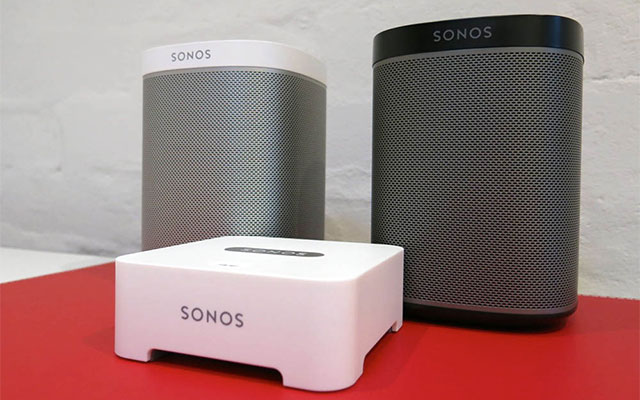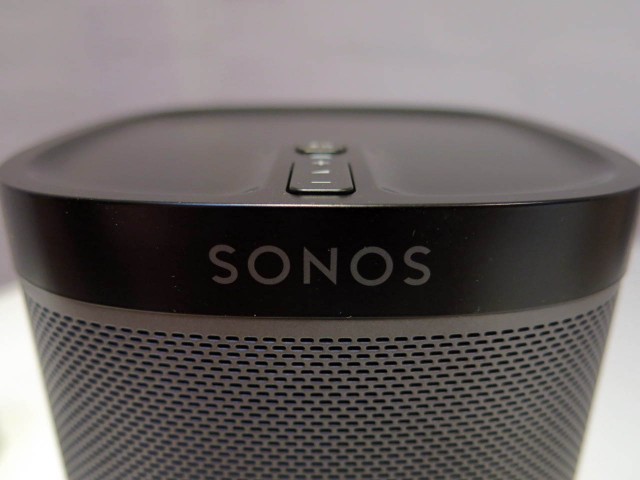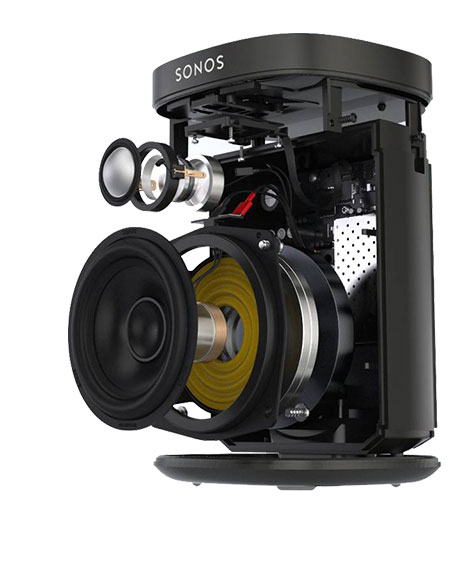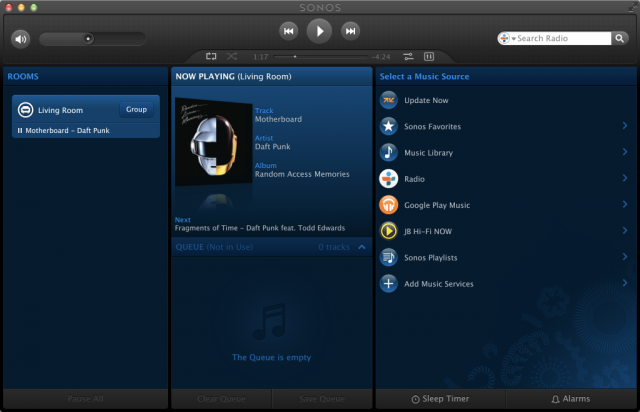
US home entertainment company Sonos calls its product “the wireless hi-fi system”. The company’s products can form a wireless network around your house and you can control what music plays on which speakers. You can play back music stored locally on your home network, or via an increasing number of streaming music services.
Sonos has been around for about 10 years now, and its equipment isn’t known for being cheap, but some of the company’s products have significantly reduced the barrier to entry in recent years. You can get started with a single Play:1 speaker (and no wireless network) if you set it up next to your router, or you can use a Bridge to handle the connection to your home network and establish the wireless connection to any other Sonos hardware in your house.
The company made some fairly big waves earlier this year when it opened its updated controller app to public beta testing. Any registered Sonos owner is allowed to participate in the test and tell the company what they think of the app and help them track down bugs. While we’re getting used to Google’s beta channels in the Play store, it’s still the exception to see big companies embracing the idea of public testing – it involves a lot of communication with your test participants, collating and responding to their feedback. Sonos has been undertaking this for a few months now, and their updated app now appears to be nearing release.
Meet the Hardware
Sonos’ speakers all come under the Play:X name. As the numbers go up, so do the volume and bass capabilities.
It starts with the Play:1, a single bookshelf-size (11.9 x 11.9 x 16cm) speaker and goes up with the Play:3 (26.9 x 13.2 x 16cm) going to the Play:5 (36.6 x 21.6 x 12.2cm) which promises “crazy” volume and bass. There’s also a Sound Bar that houses nine speakers for your home theater system, and a Sub subwoofer.
If you have an existing home audio system, there’s also a couple of Connect devices that can turn it into a Sonos-compatible system, do you don’t have to buy new speakers if you already have a setup you’re happy with.
Finally, there’s the miniature Bridge box that allows the Play speakers to connect wirelessly to a SonosNet network, and the Bridge handles the connection to the network.
If you’re looking for an outdoor system for parties, Sonos speakers are light and portable but they’re not weatherproof so you’ll need to ensure they’re covered up. You could also use a Connect:Amp with a set of weatherproof speakers.
Getting Started
When we went to report on the updated app, we realised it would be pretty difficult to write about it without an actual Sonos system to connect it to, so Sonos Australia kindly obliged us with a modest test setup consisting of a Sonos Bridge and two Play:1 speakers (one black and one white).
My music is stored in a few locations, and it’s kind of a mess. First of all there’s a couple of NAS drives with a few GB of music stored on them, then there’s my Google Play Music collection which should consist of everything already on my home network. Since I’m feeling generous, there’s also my housemate’s music to consider, because this is supposed to be an audio solution for the entire house. He has an iTunes library and a JB Hifi Now subscription.
The first thing I did was unpack and set up the Sonos Bridge and plug it into my router with an ethernet cable. This established the “SonosNet” network to which the other equipment would connect.
Next, I set up one of the Play:1 speakers in the living room. This was a simple case of unboxing it and plugging it into a power socket.
I stopped for a minute to check out just what I was looking at.

The Play:1 is a small speaker that would probably be considered a “bookshelf” speaker. It’s fairly heavy and has a decent amount of technology packed within:

Sonos has invested the time to get the engineering on the speaker itself right. Taken on its own, the black Play:1 especially is an imposing unit, and it certainly looks the part of premium high-end audio equipment. Nothing about it feels cheap or flimsy, even the custom-moulded power plug that fits firmly into the base of the speaker (amusingly, Sonos even provides a black power cable for the black Play:1 and a white cable for the white version).
The base sits on nonslip rubber feet. On the rear you’ll find an ethernet port (if you don’t have a Bridge you can plug the Play:1 directly into your router) and a screw for attaching the speaker to a stand, and on top you’ll find a physical play/pause button and volume controls.
To connect it all up, you run the Sonos app on your phone, or desktop computer. It’ll detect your SonosNet network, find any new components and ask you to push a couple of buttons on top to bring them into the SonosNet. From there you can name the component (the room it’s in is a good choice), and you can also group components together (so if you’re hosting a party for example, the same music can play to all the speakers at once).
I then went to the desktop app on my Mac to set up my music collection. I pointed it at my NAS drives and went searching for music subscription services.

A single Play:1 speaker can boom loud enough to fill the room with high quality audio, although it’s still only a single channel. Sonos’ software is also smart enough to pair two Play:1 speakers together if you want stereo sound, or you can buy different equipment.
The Sonos App
Sonos’ new app is a welcome coat of paint over the old-school blue-themed interface that Sonos has had going for a few years now. It’s not particularly Holo-y, but it’s also sleek, simple and inoffensive enough that it doesn’t really matter.
Browsing content in any of the libraries or services you’ve configured is nice, but after using an app like Google Play Music it’s not always particularly exciting. The experience isn’t always as visual as you might like after using some other music apps, but it doesn’t skimp on things like playlist management and you’re always in control of what music is playing where in your house.
If there’s a criticism to be leveled at the app, it’s probably that navigation options aren’t always obvious because UI elements that are buttons aren’t denoted as such. Upward navigation is accomplished by tapping on the ‘SONOS’ logo at the top-left of the app, but there’s never a ‘<' arrow displayed next to it to indicate as such, and clicking on the current room to get to the rooms menu isn't very intuitive. These particular navigational quirks though, users learn to handle very quickly. Ultimately, Sonos has brought a much-needed fresh coat of paint over its old app with a new font and a nice modern design and that’s good enough. [gallery link="file" columns="2" ids="65789,65790"] If you’re using multiple Sonos speakers in your house, you can arrange them as a group to get the same music playing on each speaker in sync. A useful capability for parties. [gallery link="file" columns="2" ids="65794,65791,65792,65793"] Speaking of parties, you can also let guests control the playlist if they’re on your Wifi network with the Sonos app installed. Another neat trick, although you’ll probably want to be sure that there won’t be a fight over whatever music is currently playing. Sonos doesn’t seem to offer this kind of protection - a proper “party mode" where guests can select music to add to the playlist but not override it would be cool. You can start music playing with the Sonos desktop app, then pick up your phone and find a notification telling you what’s playing and take control from there. The app can also handle software update duties for the Sonos components, a neat trick that reduces reliance on your desktop system. One thing you will still need a desktop app for though is setting up your local library - telling Sonos where to find your music, be it a NAS, an iTunes library or just a shared directory full of MP3 files. Either desktop or mobile app has the ability to start playing any song in your collection or stream from any Sonos-supported service. After exploring the system in late March, a pang of disappointment set in - support for Google Play Music, particularly in its All Access form where it's the ultimate subscription service for those us us living in Google’s ecosystem, was nowhere to be found. I could tell this was going to sting after I had embraced the service in 2013 and moved most of my music to Google's cloud. Undeterred, I set up a trial JB Hifi Now account which allows 10 days’ access to the entire service’s streaming catalog. The result was pretty cool - I could play any song (within reason) to either of the Play:1 speakers in my house without moving from the couch. Having recently set up a Chromecast, it had changed the way I thought about how I wanted to trigger music playback around my house, and it revealed a slight annoyance about the technology on offer in Sonos’ products.
I didn’t want to have to use the Sonos app to play music. In a Google Cast environment, each app with content is responsible for defining a player that the Cast receiver can run in order to play what you want it to play. Given that this is essentially how Sonos’ systems already worked, I figured it should be easy enough for them to add support for Google Cast.
I emailed Sonos asking about integrating Cast and Google Play Music – since they were making a big push in the direction of Android with the new app, I thought it might be good to plant these seeds if they hadn’t already considered them. Sonos told me to wait until April 11 and promised I’d like what they had to say. They were right.
Cast by any other name
On April 11 I got everything I wanted – not only did Sonos support Google Play Music, but I could actually cast music from my Play Music app to particular Sonos speakers in my house! A major campaign started from both Sonos and Google promoting the new integration between the two services.
You can now set up your Google Play Music All Access account within the Sonos app.
Sonos is reportedly not actually using Google’s “Cast” API, but its been whitelisted by Google to allow its connections to appear under the Cast menu in PLay Music. As far as users are concerned, it’s the same thing. I almost never use the Sonos app now, but rather use the same Play Music app I use when I’m out walking, on public transport or at work and I just tell it where I want to output the audio.
You do need to have the Sonos app installed on your phone to allow Play Music to see the Sonos speakers, but you don’t actually have to run it. Play Music will see the speakers or groups that have been configured in the Sonos app.
You’ll also have access to all the Google Play Music options within the Sonos app.
Feeling Blue
Music playback is all well and good, but there’s another notable drawback to the system, if Bluetooth audio is important to you.
For all the technology in the speakers, Sonos doesn’t support local Bluetooth audio connections, so the speakers won’t do double duty as audio output from your phone, tablet or computer. This is a bit of a bummer as I would actually like some speakers to use with my Mac, and it means I’d need to buy another piece of equipment to handle that.
It’s a shame if Bluetooth is important to you, but maybe it’s unnecessary in the Sonos world. You could make the case that anything on my computer in an iTunes library would be accessible through Sonos anyway, and given my Chromecast setup elsewhere in the house the number of times I actually would want to play a video with audio output to speakers in my room is probably pretty low. Equally, if you do want Bluetooth speakers you’ll probably already have them.
If Bluetooth is important to you though but you still want to play in Sonos-land, you could use the analog input on some of the higher-end Play:5 speakers with a Bluetooth adapter, as long as the speaker is close enough to your computer (or mobile device). The Play:5 might be overkill for a bedroom or study, though.
Similarly, if I’m playing audio on my phone in an app that supports Casting (eg, Pocket Casts), it’d be nice to be able to cast to the Sonos speakers – this is currently not possible as Sonos’ integration only goes as far as Play Music.
Ultimately, I’ve survived this long without a Bluetooth speaker. Maybe I don’t really need one. Do you?
Affordability vs Convenience
Once you move beyond a basic Play:1 speaker, the cost of running a Sonos setup can go up pretty fast. While a Play:1 speaker generally run about $300, the Play:3 speakers are $449, the Play:5 speakers are $599 and the Sound Bar won’t leave you any change out of your $1000. If you place more than one speaker in your house, the Bridge is a comparatively cheap addition at about $75.
All of these prices aren’t really a surprise for those setting up a high-end home theatre and they can be justified by the quality of components on offer, if that’s what you’re into.
If you’re going to set up speakers in a living room, you’d probably go for a Play:5 with its stereo sound instead of two Play:1s. Either would work, but it depends how much coverage and spread you want in your music.
With Sonos’ reputation as premium home entertainment equipment, you might find that the components are available as rewards in your airline’s frequent flyer or your bank’s credit card reward programs.
Sonos is also further developing their products, looking to do away with the Bridge requirement, but they’re only at the stage of asking interested parties to sign up for a 6 month testing period so it’s early days there. The Bridge is a small investment relative to the rest of the equipment, though.
Update, October 2014: After a recent update, Sonos products now no longer require the Bridge to get a network up and running. You also no longer need to connect speakers directly to your router, which means the process of setting up a Sonos system is now even simpler. Not having to buy a Bridge reduces the cost of getting a Sonos system up and running, and it’s worth remembering that many of Sonos’ new competitors currently use the bridge model.

Services
A Sonos system can play audio from a number of sources:
- Computer / NAS – either files on a shared network drive, or an iTunes library
- Internet Radio – Any station supported by Tune In radio
- Subscription Services – Spotify, Rdio, Rhapsody, Deezer, MOG, Last.fm, Pandora and more — obviously, now including Google Play Music All Access. Click here for the full list
You can also get line-in audio support on the higher-end Play:5 speakers and the Connect devices.
I’m buying one
Sonos is ultimately a pretty cool addition to the house, but justifying the outlay can be difficult. It’s not actually doing anything you can’t do on the cheap, but that would mean messing with a bunch of additional hardware and inconveniences – for instance, you’d be relying on a Bluetooth connection and draining the battery on your phone by having it decode the audio files to output to your speakers. Managing multiple rooms on the cheap is difficult, if not impossible.
My housemate and I now both have the Sonos app on our phones and our Macs. We can play anything we like in either of our iTunes or Google Play Music collections or streaming services, and it’s a tough proposition to go back to our previous solution – a dinky little set of speakers plugged into whatever device is playing music.
Ultimately, what Sonos brings to the table is simplicity and convenience, and it does it in a way that’s familiar to those of us who are starting to move into Google’s Casting world. You run the app, tell it what to play and you’re done. Sonos has done the heavy lifting and engineering needed to make this work behind the scenes and hides the technology well.
If I were buying everything with cash-money, I’d probably start with a setup mirroring our review configuration – a Play:1 in the living room and a Bridge, then move the living room up to a Play:3 or Play:5 and put the Play:1 in my bedroom.
Mind you, there’s a Play:5 speaker listed in my bank’s credit card awards program that’s calling my name, so I may go straight to the Play:5 / Play:1 setup.
Sonos products are available from JB Hi-Fi, Harvey Norman and Myer. You’ll also find them online at Lasoo and a number of dealers listed on StaticIce. Check out their main site: Sonos.com, and their Store Locator.
Disclosure: At the time of writing, the Sonos components on review were understood to be on a one-month loan basis. Since publishing the review, Sonos Australia has allowed us to keep the review products. This offer in no way impacted the review (having come after publication), and it means Ausdroid will be able to report on future Sonos software and hardware developments.


























While researching the Sonos system I came across “Beep”. It offers the synced music, hosted streaming, a fraction of the ridiculous cost of Sonos and I keep the speakers in the house I already have and love.
http://thisisbeep.com
If someone ends up buying one, could you use my referal link? http://thisisbeep.com/QwKzGdcW
Oh and check out my post on OzBargain to get them for $59! https://www.ozbargain.com.au/node/140357
Excellent review, thanks. Weighs up pros and cons nicely.
I wouldn’t call Sonos product high-end audio. Most audiophiles laugh at the output and “cost” of Sonos product offering. Bose now offer a alternative with their SoundTouch systems, but if you are after high end audio you are forking out well more than $1000 for a speaker!
Fair comment. I’m not an audiophile (to me, “loud enough to be heard” is usually good enough). I tried to avoid talking about the sound quality too much.
Given that many folks will be using streaming audio or playing from a compressed MP3/AAC source though, we’re probably starting from a different baseline too 🙂
i think the true test of a review is whether the reviewer is willing to part with their own hard-earned to buy the product after. Jason is doing just that. I don’t have a sonos myself but a friend has a couple Play 3s and he loves them. The wireless solution is amazing. If I ever have any spare $ I’ll be buying some.
Thanks for this review. I’ve been looking at getting some bookshelf speakers. Do more of these in the future please!
I do love a good wireless audio solution, most people don’t know about it but Logitech released Squeezebox products that were cheap (well I bought them cheap) and a great product. The boom has great sound for a small unit and the touch is really nice attached to my amp, no need to turn the TV on etc, control from the touch interface or from the phone, play different music in different rooms or sync it all together. Alas Logitech killed the product range and Sonos have taken over. The controller is the biggest problem they have, why tie everything… Read more »
hmmm… or a very cheap Chromecast can allow you to do the same with your existing HiFi system.
Am I missing something or would the only benefit of Sonos over Chromecast be playing to multiple rooms at once?
I have a couple of chromecasts hooked up to TVs connected to nice speaker systems – seems to me a better method – am I missing something?
Yes you are. You have to turn the tv on, run that and pay for it, turn the amp on to power the speakers etc. it is a hassle but obviously works for you and in the end that is all that matters.
true, though the Chromecast turns on the TV when I connect to it from my phone and the amp is shamefully always on 😉
Guess it works better than Chromecast if you need sound in a room with no TV.
I struggle to believe it produces sound commensurate with the price though. Once you look at a multiple speaker set up – say 2.1, or even soundbar+sub, it seems you could get some damn good HiFi components for the same money – do the Sonos speakers really compete with a $2000 amp+speaker setup?
Third paragraph in the ‘Meet the hardware’ section says that you can use Sonos Connect gear with an existing home audio system.
That’s the Sonos stuff I’d look at getting.
I have heard of folks running Chromecast connected to a HDMI port on their amplifier. It’d work if you have an existing setup that can support it, but you’d lack any visual feedback from the Chromecast if something is wrong.
You would indeed miss out on the multi-room control aspects and probably also local file playback from a NAS box (unless you have an app that can do that).
Other than that, you’d also be limited to using apps that support Cast, whereas Sonos has a controller UI that lets you access content from a number of supported services.